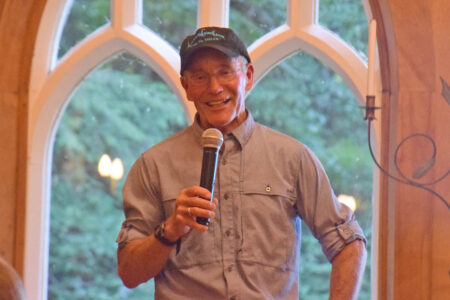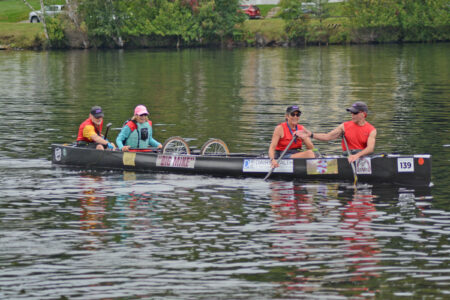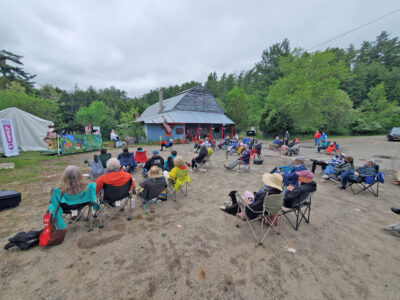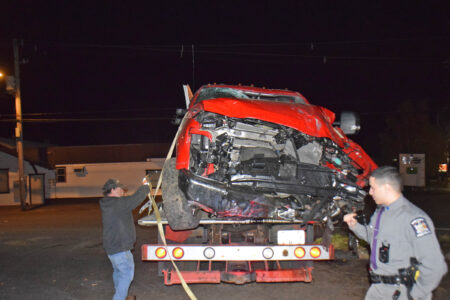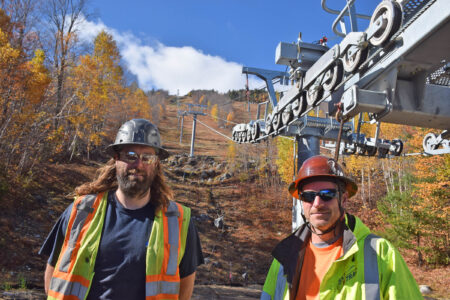Crash course 90
- 90-Miler longtime paddler Peter Ostrum, a retired veterinarian and “Willy Wonka & the Chocolate Factory” child actor, gives a presentation on the race at the Big Moose Commumnity Chapel in Big Moose on Sun. (Enterprise photo — Chris Gaige)
- Team “Big Mike” celebrates after crossing the 90-Miler’s finish line on Sept. 10, 2023 on Lake Flower in Saranac Lake. From left, Brian Sanders, Robert Shapiro, Wendy Sanders and Peter Ostrum. (Enterprise photo — Parker O’Brien)
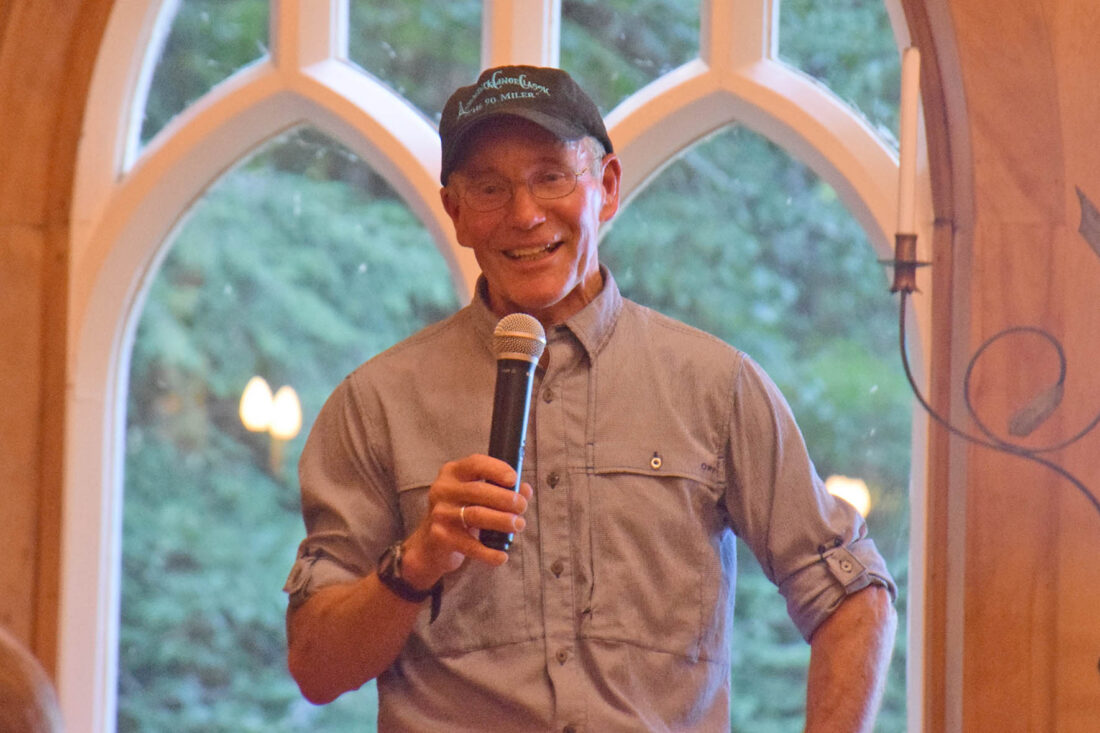
90-Miler longtime paddler Peter Ostrum, a retired veterinarian and “Willy Wonka & the Chocolate Factory” child actor, gives a presentation on the race at the Big Moose Commumnity Chapel in Big Moose on Sun. (Enterprise photo — Chris Gaige)
BIG MOOSE — Peter Ostrum has worn a lot of hats throughout his lifetime. Now retired, he spent a career as a large-animal veterinarian in the Black River Valley. Before that, and perhaps what he is most widely known for, Ostrum was a child actor who starred as Charlie Bucket in the 1971 film “Willy Wonka & the Chocolate Factory.”
On Friday, Ostrum stood before a captive audience at the Big Moose Community Chapel in the western Adirondacks. He was there to give a lecture on one of his favorite pursuits — marathon canoe racing — and specifically on the race that defines the sport locally: the Adirondack Canoe Classic.
More commonly known as the 90-Miler, the three-day canoe, kayak, guideboat and — believe it or not — stand-up paddleboard race has taken place each fall on the weekend following Labor Day since 1983, save for a lone cancellation in 2020 due to the coronavirus pandemic. The event, which begins in Old Forge and ends in Saranac Lake, was originally organized by Sue Dyer and kicked off in 1983. Since then, it has grown in popularity, constantly filling its registration, which is capped at 250 boats for safety and logistical reasons.
Ostrum said 2025 will be his 12th year running the race. He’s registered in the “C-4 Open” class — which is jargon for four-seat canoes specially built for speed. Often made with carbon fiber, boats in this class are long, narrow and light. They are usually paddled by dedicated teams that tend to clock the top overall finishing times year in and year out.
“We all kind of take it pretty seriously,” Ostrum said. “But that’s part of the fun of doing it.”
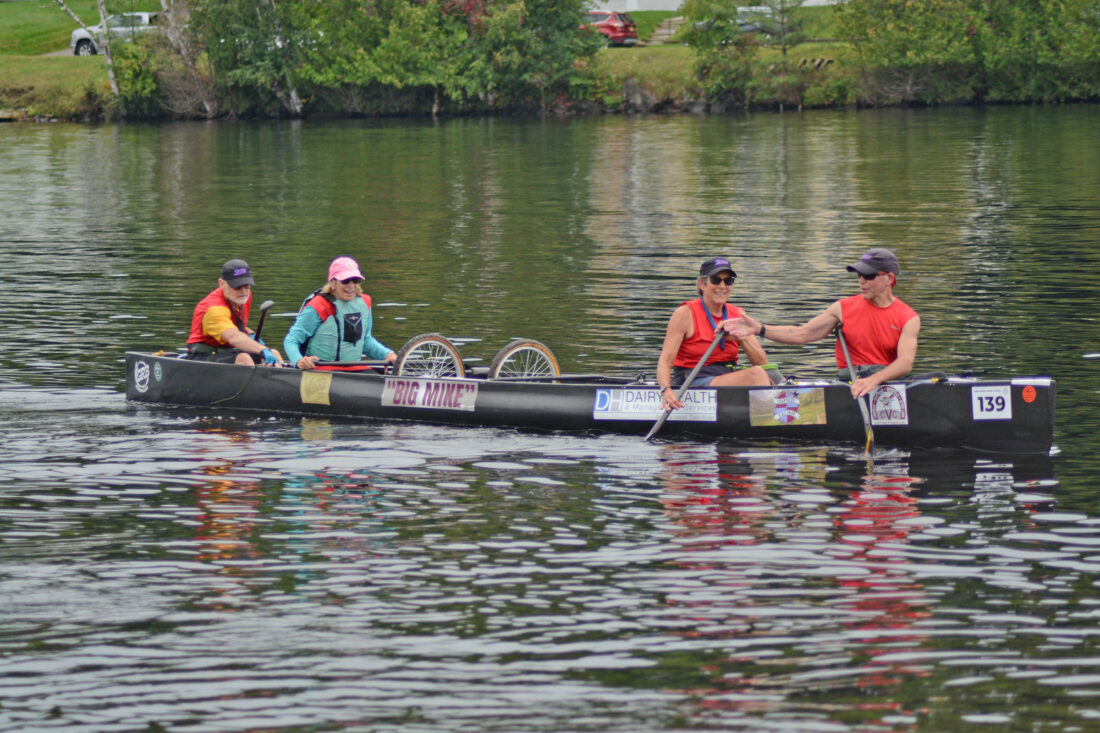
Team “Big Mike” celebrates after crossing the 90-Miler’s finish line on Sept. 10, 2023 on Lake Flower in Saranac Lake. From left, Brian Sanders, Robert Shapiro, Wendy Sanders and Peter Ostrum. (Enterprise photo — Parker O’Brien)
Ostrum’s team and their boat — a Grasse River Boatworks Mach 4 canoe — are named “Big Mike,” in memory of paddling partner and boat-owner Wendy Sanders’ father, who died several years ago. Ostrum said that out of the several hundred racers each year, maybe 15% are “in it to win it.”
“Everybody else is just trying to finish the race, which is great,” he said. “People who will do this race year after year, they see their friends, they see their family again, it’s a social event as well as a race.”
Ostrum said the race is filled with racers of all ages, from young kids to those in their golden years. He said canoe racing offers older athletes not only the chance to keep paddling, but also to do so at a competitive level.
“You can paddle a long time, well into your senior years,” he said. “As a runner, I can’t run like I used to — but I can paddle. It’s one of the nice things about the sport.”
While athleticism is, of course, a major component of an elite performance, Ostrum said high-caliber paddling requires such refined technique, especially when paddling a boat in sync as a team, that it can give longtime paddlers a leg up over the field — even as some younger competitors might be in stronger physical shape.
Ostrum demonstrated for the crowd what good technique includes. He said that while simply paddling a boat for leisure involves a fairly perfunctory stroke, paddling for speed is something else entirely. He noted that the blade needs to be as close to perpendicular to the water as possible, with any side angling throwing the boat’s direction off just a bit.
Ostrum explained that while it seems intuitive to paddle “with the arms,” the serious racers are drawing almost all of their energy from their core and back muscles, and minimizing their arm muscles during the race. While optimizing paddle performance as an individual takes skill, Ostrum said the team dynamics inherent to maximizing efficiency in a four-person boat is another endeavor altogether.
Team Big Mike — which this year includes Brian Sanders and Brienne Basford in addition to Ostrum and Wendy Sanders — participates in a number of tune-up summer races each year and practices together frequently.
Cadence to ensure paddling in unison is a key focus at practice. Part of a good rhythm involves switching paddling sides frequently in order to keep the boat in a straight line. That’s done using voice commands, where one paddler, usually the person in the stern, will call “hut,” and everyone switches at once then. Ostrum said that tends to happen every eight or nine strokes and requires everyone to pay close attention. He added that things can get chaotic at the start lines or in channels when there are numerous boats in close quarters with each other, all calling “huts” at the same time.
With a large field of boats, crafty racers often try to draft one another. The concept is similar to cycling, where the leader breaks the wind resistance, allowing those just behind them to get an easier ride. In canoe racing, the lead boater creates a wake, and the boats drafting behind maneuver themselves onto the waves, partially surfing their momentum to get some “free power.”
While it might only feel like a bit of a boost in the moment, Ostrum said that since each day of the race is between 22 and 34 miles long, the energy boats save by drafting quickly adds up, and its something that savvy paddlers are often seen doing — adding that they make it look easier than it is, as staying on the wave requires precise strokes.
Another team component for the 90-Miler is navigating portages, or carries over land. During the race’s three days, there are eight separate portages that total over 5.3 miles. Many racers use a set of detachable wheels that are deployed and strapped underneath the canoe’s hull, so it can be pushed and pulled along land like a wagon. Ostrum said wheel mounting and dismounting is its own discipline within team practices.
“When you’re racing, obviously seconds count, so we spend a lot of time making sure the wheels come on and off properly,” he said. “Everybody has a role when we do that.”
When it comes to hydration and nutrition during the race, Ostrum said he prefers to consume a carbohydrate and electrolyte-dense liquid so he can get his food and water in one uniform intake. Others, he said, prefer to keep their liquids and solids separate. Ultimately, it comes down to individual preference.
“Everybody kind of figures out what works or what doesn’t work for their stomach in doing this,” he said. “But you’ve got to stay hydrated.”
Moisture-wicking clothing is essential, Ostrum said, adding that part of Big Mike’s team camaraderie is wearing matching uniforms, with each day featuring its own bright color. He said that it was both to stand out for the pit crew and also for style.
“We’re not the fastest,” he said. “I mean, we’re competitive, but there are people who are much faster than ourselves. But, at least we kind of look good.”
Ostrum said that pit crews are indispensable for paddlers in the 90-Miler. Not only do they resupply food and water at various access points along the course, but since each day starts and ends at a different location miles away, they are needed to shuttle vehicles.
Past weather has ranged anywhere from a blistering heat index approaching 90 degrees Fahrenheit to a rain/snow mix. Weather is at the forefront of decision-making for race organizers and safety officials. Ostrum said the race has been delayed, suspended or called off over the years by wind, fog or lightning — adding that the original course was modified from Forked Lake to Blue Mountain Lake to minimize course time on Raquette Lake on day one after successive years of intense winds there.
This year’s 90-Miler is organized by the Northern Forest Canoe Trail and is set for Sept. 5-7. Day one starts in Old Forge and ends in Blue Mountain Lake. Day two starts in Long Lake and ends at “The Crusher” state boat launch on the Raquette River about 3 miles east of the Tupper Lake village line. Day three begins at the Fish Creek Pond Campground and ends in Lake Flower in the village of Saranac Lake. For more information, visit tinyurl.com/yc4a899x.

